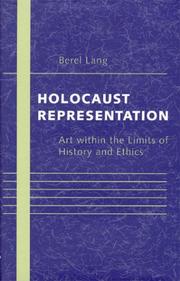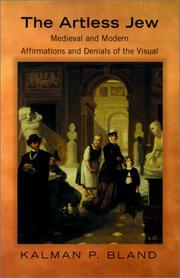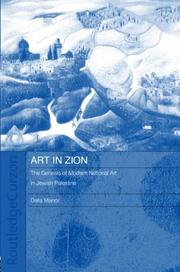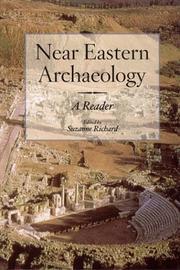| Listing 1 - 10 of 10 |
Sort by
|

ISBN: 0801864151 0801876362 0801877458 9780801876363 9780801864155 9780801877452 Year: 2000 Publisher: Baltimore Johns Hopkins University Press
Abstract | Keywords | Export | Availability | Bookmark
 Loading...
Loading...Choose an application
- Reference Manager
- EndNote
- RefWorks (Direct export to RefWorks)
At an extreme, all Holocaust representation must face the test of whether its referent would not be more authentically expressed by silence--that is, by the absence of representation.
Book
ISBN: 128060543X 9786610605439 0195362861 9780195362862 0197716547 Year: 1990 Publisher: New York Published for the Institute by Oxford University Press
Abstract | Keywords | Export | Availability | Bookmark
 Loading...
Loading...Choose an application
- Reference Manager
- EndNote
- RefWorks (Direct export to RefWorks)
This volume analyses the levels of meaning present in a wide range of visual images - from high art by Jewish artists to Judaica, caricatures, and political propaganda.
Jewish art. --- Jews in art. --- Jews --- Jewish life --- Jewish way of life in art --- Art, Jewish --- Hebrew art --- Judaism and art --- Art --- History --- Social life and customs. --- Customs --- Ritual
Book
ISBN: 9075463197 Year: 1999 Publisher: Mechelen Cultureel Centrum Spinoy
Abstract | Keywords | Export | Availability | Bookmark
 Loading...
Loading...Choose an application
- Reference Manager
- EndNote
- RefWorks (Direct export to RefWorks)
Art --- Catalogues d'expositions --- Jodendom --- Judaïsme --- Kunst --- Tentoonstellingscatalogi --- Joodse kunst --- België --- kunst 20e eeuw --- 7.038(493) --- kunstgeschiedenis België - kunst na 1945 --- Exhibitions --- Art, Belgian --- Jewish art --- Art, Jewish --- Hebrew art --- Judaism and art --- joden (themawoord fictie) --- anno 1950-1959 --- anno 1960-1969 --- anno 1970-1979 --- anno 1980-1989 --- anno 1990-1999
Book
ISBN: 019025470X 0199934258 019993424X 9780199934256 1299669247 9781299669246 9780199934249 Year: 2012 Publisher: New York : Oxford University Press,
Abstract | Keywords | Export | Availability | Bookmark
 Loading...
Loading...Choose an application
- Reference Manager
- EndNote
- RefWorks (Direct export to RefWorks)
Continuing its distinguished tradition of focusing on central political, sociological, and cultural issues of Jewish life in the last century, Volume XXVI of the annual Studies in Contemporary Jewry examines the visual revolution that has overtaken Jewish cultural life in the twentieth century onwards, with special attention given to the evolution of Jewish museums. Bringing together leading curators and scholars, Visualizing and Exhibiting Jewish Space and History treats various forms of Jewish representation in museums in Europe and the United States before the Second World War and inquires
Jewish art. --- Jewish artists --- Jewish museums --- Jewish museums. --- Museums --- History. --- Collection management. --- Collection management in museums --- Collections management in museums --- Museum collection management --- Museum collections management --- Jews --- Artists, Jewish --- Art, Jewish --- Hebrew art --- Collections management --- Museum techniques --- Museum storage facilities --- Artists --- Judaism and art --- Art --- Judaica museums --- Judaism

ISBN: 1282767003 9786612767005 1400823579 1400811074 9781400811076 9781400823574 9781282767003 069108985X 9780691089850 0691010439 9780691010434 069108985X 9780691089850 1400800757 Year: 2001 Publisher: Princeton, NJ
Abstract | Keywords | Export | Availability | Bookmark
 Loading...
Loading...Choose an application
- Reference Manager
- EndNote
- RefWorks (Direct export to RefWorks)
Conventional wisdom holds that Judaism is indifferent or even suspiciously hostile to the visual arts due to the Second Commandment's prohibition on creating "graven images," the dictates of monotheism, and historical happenstance. This intellectual history of medieval and modern Jewish attitudes toward art and representation overturns the modern assumption of Jewish iconophobia that denies to Jewish culture a visual dimension. Kalman Bland synthesizes evidence from medieval Jewish philosophy, mysticism, poetry, biblical commentaries, travelogues, and law, concluding that premodern Jewish intellectuals held a positive, liberal understanding of the Second Commandment and did, in fact, articulate a certain Jewish aesthetic. He draws on this insight to consider modern ideas of Jewish art, revealing how they are inextricably linked to diverse notions about modern Jewish identity that are themselves entwined with arguments over Zionism, integration, and anti-Semitism. Through its use of the past to illuminate the present and its analysis of how the present informs our readings of the past, this book establishes a new assessment of Jewish aesthetic theory rooted in historical analysis. Authoritative and original in its identification of authentic Jewish traditions of painting, sculpture, and architecture, this volume will ripple the waters of several disciplines, including Jewish studies, art history, medieval and modern history, and philosophy.
Jewish aesthetics. --- Jewish art. --- Jews -- Intellectual life. --- Judaism and art -- History of doctrines. --- Ten commandments -- Images. --- Judaism and art --- Jewish art --- Jewish aesthetics --- Jews --- Religion --- Philosophy & Religion --- Judaism --- Hebrews --- Israelites --- Jewish people --- Jewry --- Judaic people --- Judaists --- Ethnology --- Religious adherents --- Semites --- Aesthetics, Jewish --- Art, Jewish --- Hebrew art --- Art --- Art and Judaism --- History of doctrines --- Intellectual life --- Intellectual life. --- History of doctrines. --- Ten commandments --- Images.
Book
ISBN: 0253015421 9780253015426 9780253005984 0253005981 Year: 2015 Publisher: Bloomington
Abstract | Keywords | Export | Availability | Bookmark
 Loading...
Loading...Choose an application
- Reference Manager
- EndNote
- RefWorks (Direct export to RefWorks)
Jewish art and visual culture-art made by Jews about Jews-in modern diasporic settings is the subject of Looking Jewish. Carol Zemel focuses on particular artists and cultural figures in interwar Eastern Europe and postwar America who blended Jewishness and mainstream modernism to create a diasporic art, one that transcends dominant national traditions. She begins with a painting entitled Albert: Used to Be Abraham, a double portrait of a man, which serves to illustrate Zemel's conception of the doubleness of Jewish diasporic art. She considers two interwar photographers, Alter Kacyzne and Mos
Art, Modern --- Jews in art. --- Jewish art. --- Contemporary art --- Modernism (Art) --- Affichistes (Group of artists) --- Fluxus (Group of artists) --- Schule der Neuen Prächtigkeit (Group of artists) --- Zero (Group of artists) --- Jewish way of life in art --- Art, Jewish --- Hebrew art --- Judaism and art --- Art
Book
ISBN: 1612492363 155753635X Year: 2012 Publisher: Purdue University Press
Abstract | Keywords | Export | Availability | Bookmark
 Loading...
Loading...Choose an application
- Reference Manager
- EndNote
- RefWorks (Direct export to RefWorks)
In the late nineteenth century in Europe and to some extent in the United States, the Jewish upper middle class—particularly the more affluent families—began to enter the cultural spheres of public life, especially in major cities such as Vienna, Berlin, Paris, New York, and London. While many aspects of society were closed to them, theater, the visual arts, music, and art publication were far more inviting, especially if they involved challenging aspects of modernity that might be less attractive to Gentile society. Jews had far less to lose in embracing new forms of expression, and they were very attracted to what was regarded as the universality of cultural expression. Ultimately, these new cultural ideals had an enormous influence on art institutions and artistic manifestations in America and may explain why Jews have been active in the arts in the twentieth and twenty-first centuries to a degree totally out of proportion to their presence in the US population. Jewish cultural activities and aspirations form the focus of the contributions to this volume. Invited authors include senior figures in the field such as Matthew Baigell and Emily Bilski, alongside authors of a younger generation such as Daniel Magilow and Marcie Kaufman. There is also an essay by noted Los Angeles artist and photographer Bill Aron. The guest editor of the volume, Ruth Weisberg, provides an Introduction that places the individual contributions in context.
Jews --- Jewish art and symbolism --- Jewish art --- Identity --- In art --- History and criticism. --- Themes, motives --- Art, Jewish --- Hebrew art --- Judaism and art --- Art --- Jewish symbolism and art --- Jewish arts --- Symbolism --- Symbolism in art --- Hebrews --- Israelites --- Jewish people --- Jewry --- Judaic people --- Judaists --- Ethnology --- Religious adherents --- Semites --- Judaism --- Social & cultural history
Book
ISBN: 9061529492 9789061529491 Year: 1996 Publisher: Leuven Davidsfonds
Abstract | Keywords | Export | Availability | Bookmark
 Loading...
Loading...Choose an application
- Reference Manager
- EndNote
- RefWorks (Direct export to RefWorks)
Dit fotoboek brengt het leven en de geschiedenis van het joodse volk in beeld en schetst 2.000 jaar Europese cultuur die zich voedde met het joodse erfgoed. De volgende onderwerpen worden belicht: de diaspora, de vervolgingen en de Holocaust; de riten, feesten en gebruiken; architectuur, ceremoniële kunst, muziek, boek-, schilder- en filmkunst; talen en literatuur.
History of civilization --- Jewish religion --- Europe --- Art [Jewish ] --- Art juif --- Beschavingsgeschiedenis --- Europa --- Histoire des civilisations --- Jodendom --- Judaïsme --- Kunst [Joodse ] --- -Jews --- -Academic collection --- #GGSB: Jodendom --- #GGSB: Joden & Christenen --- #GOSA:XV.Jod.M --- C3 --- overzicht --- cultuurgeschiedenis (x) --- joden (x) --- Europa [werelddeel] --- iconografisch materiaal --- Joden --- joodse cultuur --- geschiedenis --- 903.5 --- Hebrews --- Israelites --- Jewish people --- Jewry --- Judaic people --- Judaists --- Ethnology --- Religious adherents --- Semites --- Judaism --- Ethnic relations --- Civilization --- History --- Kunst en cultuur --- geschiedenis van de joden, joodse identiteit --- Jews --- Joden. --- Civilization. --- History. --- Ethnic relations. --- Academic collection --- #gsdb8 --- Joden & Christenen

ISBN: 1134367821 1280231963 9786610231966 020361142X 9780203611425 9780415318365 041531836X 9781134367771 1134367775 9781134367818 1134367813 9781134367825 041531836X 9780415593083 Year: 2005 Publisher: London ; New York : RoutledgeCurzon,
Abstract | Keywords | Export | Availability | Bookmark
 Loading...
Loading...Choose an application
- Reference Manager
- EndNote
- RefWorks (Direct export to RefWorks)
Art in Zion deals with the link between art and national ideology and specifically between the artistic activity that emerged in Jewish Palestine in the first decades of the twentieth century and the Zionist movement. In order to examine the development of national art in Jewish Palestine, the book focuses on direct and indirect expressions of Zionist ideology in the artistic activity in the yishuv (the Jewish community in Palestine). In particular, the book explores two major phases in the early development of Jewish art in Palestine: the activity of the Bezalel School of Ar
Jewish art --- Zionism in art. --- Art, Jewish --- Hebrew art --- Judaism and art --- Art --- Rubin, Reuven, --- Robin, Reʼuven, --- רובין, ראובן --- Criticism and interpretation. --- Betsalʼel (Academy) --- Aḳademyah le-omanut ṿe-ʻitsuv, Betsalʼel --- Betsalʼel aḳademyah le-omanut ṿe-ʻitsuv --- Betsalʼel he-ḥadash (Academy) --- Bezalel (Academy) --- Bezalel Academy for Art and Design --- Bezalel Academy of Art and Design --- Bezalel Academy of Arts & Crafts --- Bezalel Institute --- Bezalel Kunstgewerbe Schule --- Bezalel School of Arts & Crafts --- Bezalel School of Arts and Crafts --- New Bezalel (Academy) --- New Bezalel School of Arts and Crafts --- אקדמיה לאמנות ועיצוב, בצלאל --- אקדמיית בצלאל לאמנות ועיצוב --- בצלאל --- בצלאל (אקדמיה) --- בצלאל אקדמיה לאמנות ועיצוב --- בצלאל, אקדמיה לאמנות ועיצוב --- Betsalel (Academy)


ISBN: 1575062348 1575065479 9781575065472 1575060833 9781575060835 Year: 2003 Publisher: University Park, PA
Abstract | Keywords | Export | Availability | Bookmark
 Loading...
Loading...Choose an application
- Reference Manager
- EndNote
- RefWorks (Direct export to RefWorks)
More than 60 essays by major scholars in the field have been gathered to create the most up-to-date and complete book available on Levantine and Near Eastern archaeology. -- Publisher description.
Archaeology --- Archeology --- Anthropology --- Auxiliary sciences of history --- History --- Antiquities --- History. --- Middle East --- Antiquities. --- Archäologie. --- Oudheid. --- Prehistorie. --- Archeologie. --- Weapons, Ancient. --- Underwater archaeology. --- Synagogues. --- Semitic languages. --- Scarabs. --- Samaritans. --- Numismatics. --- Mosaics. --- Metal-work. --- Jewish art. --- Jewelry. --- Iron age. --- Hieroglyphics. --- Funeral rites and ceremonies. --- Excavations (Archaeology) --- Church buildings. --- Ceramics. --- Canaanites --- Burial. --- Bronze age. --- Architecture, Ancient. --- Archaeology and religion. --- Archaeology. --- Archeologie --- Metal-work --- Weapons, Ancient --- Ceramics --- Jewelry --- Mosaics --- Scarabs --- Synagogues --- Samaritans --- Funeral rites and ceremonies --- Burial --- Church buildings --- Iron age --- Bronze age --- Jewish art --- Hieroglyphics --- Semitic languages --- Underwater archaeology --- Numismatics --- Architecture, Ancient --- Religion. --- Technological innovations. --- Histoire. --- Religion --- Bible. --- Bible --- Alter Orient. --- Middle East. --- Mediterranean Sea. --- Israel. --- Moyen-Orient --- Israel --- Antiquites. --- Funerals --- Mortuary ceremonies --- Obsequies --- Manners and customs --- Rites and ceremonies --- Cremation --- Cryomation --- Dead --- Mourning customs --- Samaritan religion --- Samaritanism --- Jews --- Jewish architecture --- Religious institutions --- Temples --- Ethnology --- Semites --- Amulets, Egyptian --- Insect forms in art and archaeology --- Decoration and ornament --- Decorative arts --- Ceramic technology --- Industrial ceramics --- Keramics --- Building materials --- Chemistry, Technical --- Clay --- Ancient weapons --- Arms and armor, Ancient --- Metalwork --- Manufacturing processes --- Metals --- Archaeological specimens --- Artefacts (Antiquities) --- Artifacts (Antiquities) --- Specimens, Archaeological --- Material culture --- Religion and archaeology --- History, Ancient --- Archaeology, Submarine --- Marine archaeology --- Maritime archaeology --- Nautical archaeology --- Submarine archaeology --- Underwater exploration --- Marine archaeologists --- Afroasiatic languages --- Ideography --- Inscriptions --- Paleography --- Writing --- Picture-writing --- Art, Jewish --- Hebrew art --- Judaism and art --- Art --- Civilization --- Burial customs --- Burying-grounds --- Graves --- Interment --- Public health --- Coffins --- Grave digging --- Churches --- Buildings --- Church facilities --- Church architecture --- Archaeological digs --- Archaeological excavations --- Digs (Archaeology) --- Excavation sites (Archaeology) --- Ruins --- Sites, Excavation (Archaeology) --- Jewellery --- Jewelry, Primitive --- Jewels --- Dress accessories --- Coloring --- Religious aspects --- Palestine --- Dawlat Isrāʼīl --- Država Izrael --- Dzi︠a︡rz︠h︡ava Izrailʹ --- Gosudarstvo Izrailʹ --- I-se-lieh --- Israele --- Isrāʼīl --- Isŭrael --- Isuraeru --- Izrael --- Izrailʹ --- Medinat Israel --- Medinat Yiśraʼel --- Stát Izrael --- State of Israel --- Yiselie --- Yiśraʼel --- Ισραήλ --- Израиль --- Государство Израиль --- Дзяржава Ізраіль --- Ізраіль --- מדינת ישראל --- ישראל --- إسرائيل --- دولة إسرائيل --- イスラエル --- 以色列 --- Mare Nostrum --- Orient --- Asia, South West --- Asia, Southwest --- Asia, West --- Asia, Western --- East (Middle East) --- Eastern Mediterranean --- Fertile Crescent --- Levant --- Mediterranean Region, Eastern --- Mideast --- Near East --- Northern Tier (Middle East) --- South West Asia --- Southwest Asia --- West Asia --- Western Asia --- Dzi͡arz͡hava Izrailʹ --- Eastern Mediterranean Region --- South West --- Asia --- Archaeology - Middle East - History. --- Middle East - Antiquities.
| Listing 1 - 10 of 10 |
Sort by
|

 Search
Search Feedback
Feedback About UniCat
About UniCat  Help
Help News
News